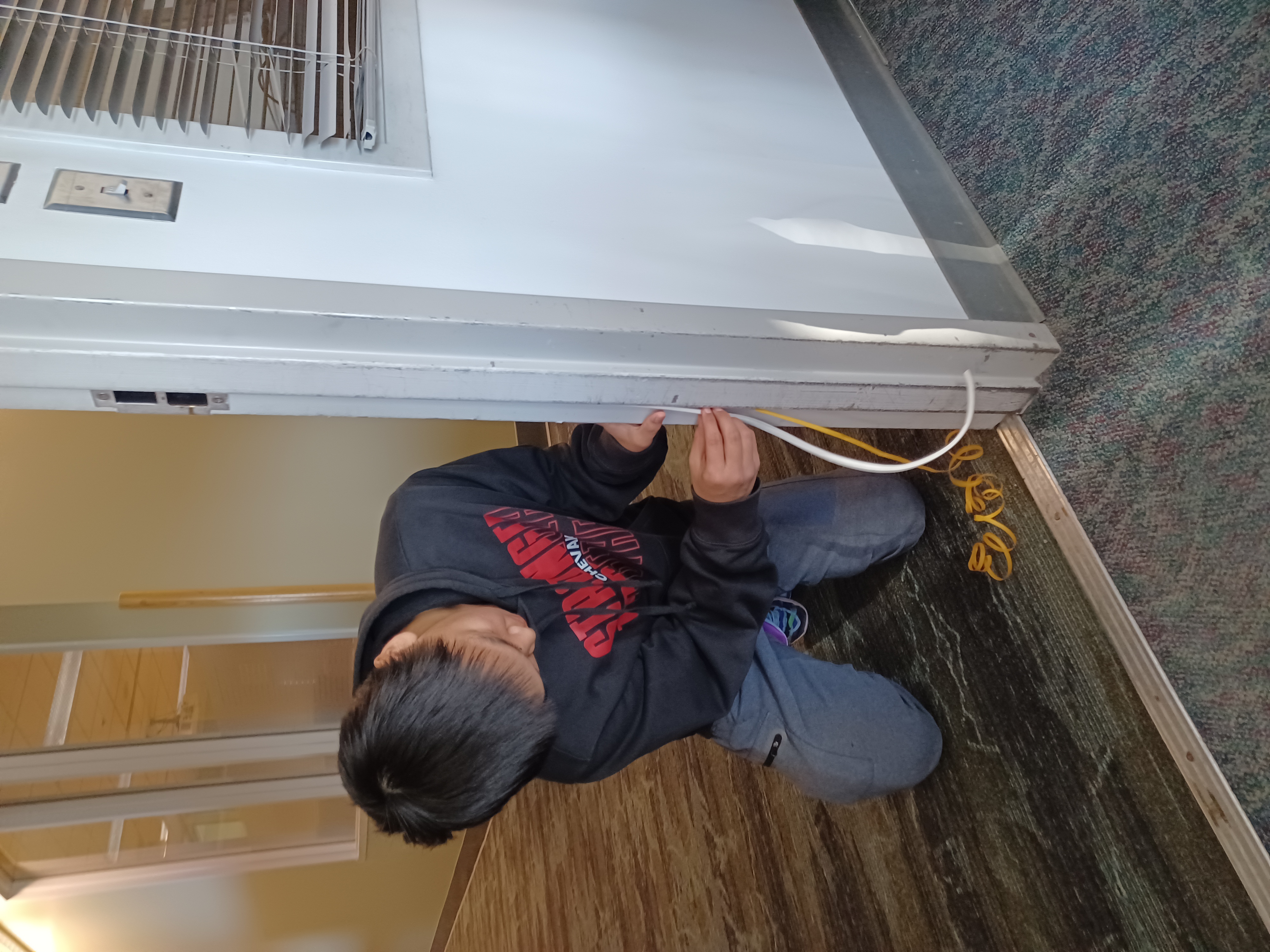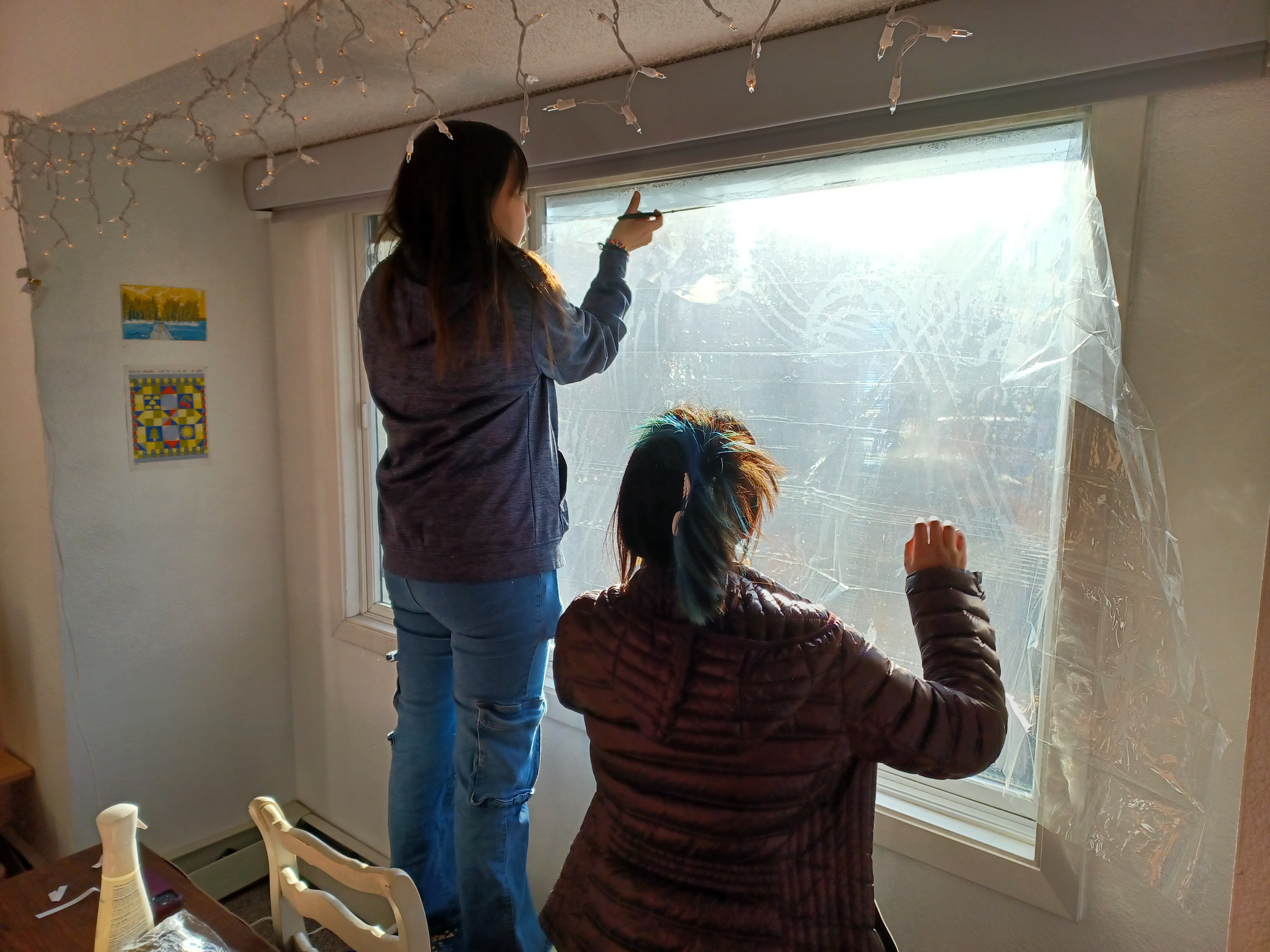ARCTIC Toolkit: Students pave the way towards energy resiliency in rural Alaska

A T3 student learns to apply weather stripping to a classroom door frame.
By Savannah Crichton
November 10, 2023
Sometimes to get a job done in rural Alaska, you have to learn how to do it yourself. Equipped with thermometers, hair dryers, and infrared cameras, Alaska Teaching Through Technology students learned how to assess a home’s energy efficiency, make recommendations and weatherize buildings with accessible materials.
Eight T3 students traveled to Anchorage from Chevak, Bethel, North Pole, Fairbanks and Sitka. In late October, their homes were already blanketed in snow, but in Anchorage only tinges of frost hid in the shadows.
George Reising, the T3 Energy Club’s leader and curriculum developer at the Alaska Center for Energy and Power, has been preparing high schoolers for this weekend with weekly meetings spent analyzing heat transfer and drawing microgrid diagrams of their hometowns. Students came into this weekend with foundational knowledge and lived experiences unique to rural, off-grid communities. They left with applicable energy auditing skills and a college credit.
On Saturday, students conducted a data recording at the University of Alaska Anchorage’s campus. One group wielded a Wattmeter to measure the amount of energy being used by appliances, another group operated a digital thermometer to understand heat transfer through walls versus windows.
Mark Masteller, an adjunct assistant professor of sustainable energy and building efficiency expert, scientifically explained the thermal envelope of a house, cold drafts and their relationship to convection, and how retrofits like door sweeps and weather stripping can make a measurable difference.
Another sustainable energy professor, Chandler Kemp, focused his lesson on the role of humidity and moisture on home heating. Kemp lives in Dillingham, and empowered students to approach energy audits in their communities with a DIY mindset.
“This class challenged students in many ways: traveling far from home, working with new people, studying novel concepts and developing hands-on skills,” Kemp said. “It was inspiring to see students rise to meet each challenge as they came.”
The ACEP team partnered with Colleen Fisk, the energy education director at the Renewable Alaska Energy Project, to provide the most impactful experience to T3’s high schoolers. Fisk underscored the fact that every energy resource has a cost — from diesel to wood to electric heaters. Applying Alaska’s incentives and rebates can dramatically lower the upfront cost of energy efficiency measures, vastly outperforming the cost of doing nothing.
“I loved watching the students' knowledge and skills grow and their excitement to apply what they've learned at home,” Fisk said.
On Sunday, the students visited three residential settings to test their skills: a house, a condo and a duplex. Walking through each layout, instructors pointed out window size, flooring material and architectural features that could contribute to heat loss.

Students work together to retrofit a condo with window film.
By taking appropriate measurements, students implemented low-barrier, low-cost changes. They unscrewed incandescent bulbs and replaced them with warm, LED counterparts that use 75% less energy. They rolled out window film, securing it to frames with hair dryers to provide added insulation. They installed weather stripping to efficiently seal door frames.
Resiliency is about rebounding from unique challenges, whether that be weathering an unpredictably brutal winter, enduring rising fuel prices or living on a microgrid off the road system. T3 students left Anchorage with a toolkit full of skills and weatherization gear that not only keep a house warm and actualize cost savings for homeowners, but also make a dynamic DIY impact within their communities.
"It was an amazing experience to learn about weatherization and it was incredible to know that there are many ways to conserve energy,” reflected T3 student Dharlene Jade Laroza. “I know I can use this skill to help my family and community."
The Alaska Regional Collaboration for Technology Innovation and Commercialization Program supports Alaska’s next generation of leaders through educational programs, like Teaching Through Technology. For more information about the T3 Energy Club, contact George Reising, gbskrabareising@alaska.edu.
This article is part of the on-going “ARCTIC Toolkit” series that features stories about the tools, skills and experiences developed by the ARCTIC program.


